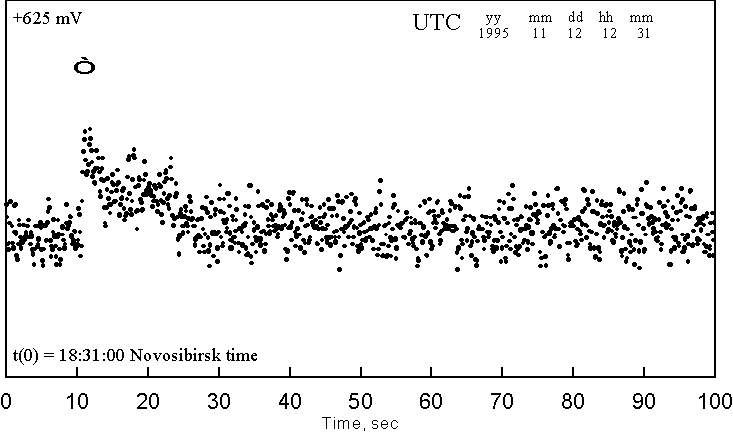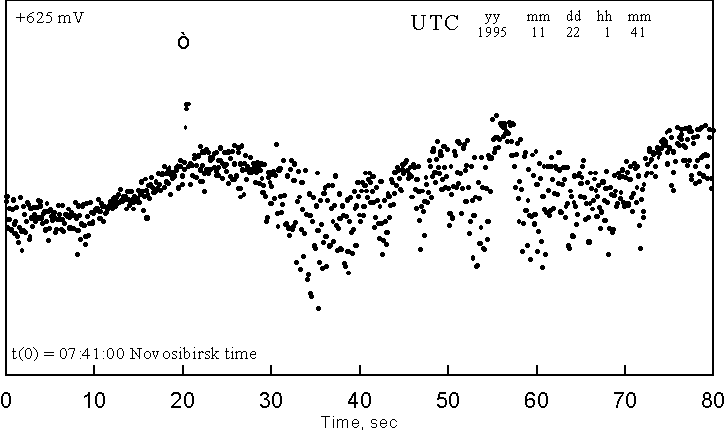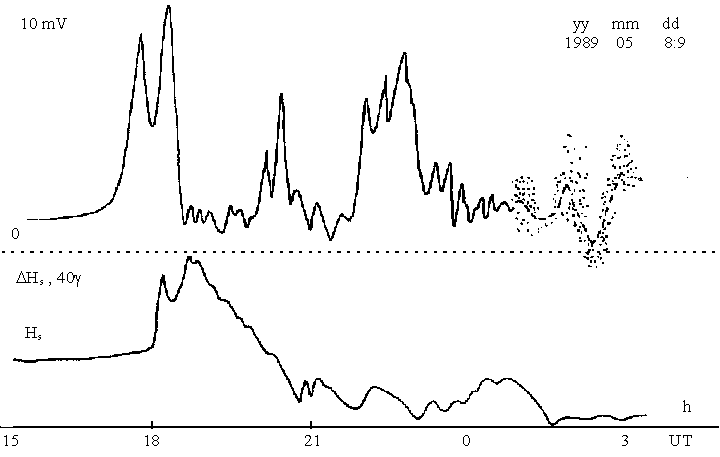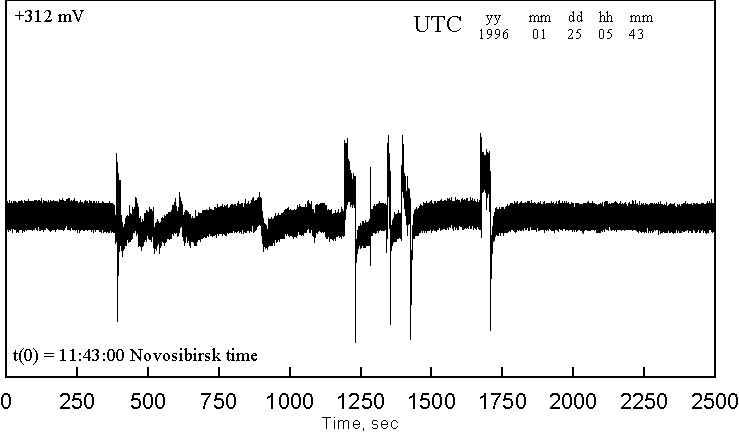Proceedings 10th International Conference on Atmospheric Electricity, June 10 - 14, 1996, Osaka, Japan, 1996, p. 440 – 443.
Yu.A.Bragin
Observatory for Atmospheric Electricity
Division for Atmospheric Research
Novosibirsk State University
Pirogova 2, Novosibirsk 630090, RUSSIA
Our rocket measurements of ion concentration, conductivity, volume charges, and electric fields have shown that electric structure of the middle atmosphere is built up in layers changing with time and different over various regions (the late 60s, all the 70s and the 80s). One does naturally suggest that such a structure forms wide-area, even global, wave guides and capacitors that conduct or generate electric signals with periods of greater than 0.01 sec.
The problem of identifying a global component of atmospheric electric field from measurements on the earth’s surface brought an observation that the properly filtered data from electric field sensors (EFSs) reflects strong disturbances of electric field elsewhere on Earth. (Five to 10 thousand ton explosions on land, some nuclear explosions, Shuttle and Energy launches, volcanic eruptions, magnetic storms, etc. The late 80s.)
The above was put into the foundation justifying a method and apparatus for receiving, acquisition, and processing of the geoelectric disturbances the source of which is far from the detection point (the early 90s). Some of the data received with the EFS apparatus, which includes antennas and personal computers, is given in the figures 1-4.

Figure 1. Start of the Shuttle, USA.

Figure 2. Nuclear explosion, the South Pacific.

Figure 3. Variation of geoelectric field (the upper curve) and South component of the Earth’s magnetic field (the lower curve) during magnetic storm.

Figure 4. A record from the measurement system for the identification of geoelectric precursors of earthquakes.
This fragments of the time runs of data measured with the instruments located in Novosibirsk. In this figures, voltage shown in the Y axis is relative, non-calibrated changes in the global component of geoelectric field. The fragments represent the disturbances of geoelectric field by the following events. For all the fragments, the beginning of the curve characterizes the background values of measured parameters. As a rule, the background amplitudes are significantly lower, and their durations are much longer, than the corresponding parameters for the disturbances.
We analyzed the data from seismic and EFS instruments placed at the one site during those powerful Tashkent earthquakes of 1966, when we started to believe that there is a relationship between earthquakes and variations of atmospheric electric field. We (and other researchers) observed local electric precursors of the earthquakes in their closer zone.
In a global component of the electric field, we discovered the electric precursors of earthquakes a few hours before they would arrive at the earth’s surface. Figure 4 shows an example of one geoelectric precursor.
Taking into account that the atmospheric electric field depends of solar events, we need, in order to explain at least global variations of geoelectric field, to model the interconnections between electric phenomena in the earth, the atmosphere, the magnetosphere, and the sun. This is a business for the future.
A criterion of reality for global precursors of earthquakes is their usefulness for prediction. The geoelectric precursors of the powerful autumn 1994 Kuril earthquakes were used for temporal and amplitude calibration of our instruments. In the beginning of 1995, we emailed the prediction of powerful earthquakes in Japan. The prediction of the May 9, 1995 earthquake in Tokyo did not come true. Predicted was a powerful Mb=7 (absolute error -1) earthquake on May 26, 1995 (On May 27, 1995, a Ms=7.6 earthquake destroyed the city of Nefteyugansk, Sakhalin). Predictions that the earthquakes of equal force would repeat there did not come true. Earthquakes with Mb being about 6.5 were predicted to happen at 6 h and 21 h UTC on February 9, 1995. These earthquakes happened at 18 h on February 8 (-12 h error) and at 5 h on February 10 (+8 h error). Earthquakes with Mb greater than 6.5 happen two times a month on average. Therefore, the probability of 1% accurate prediction is 1. Powerful earthquakes were predicted to happen at 16 h and 18 h UTC on February, 21. They were not noticed by the world seismic network.
We do not attempt here explanation why some predictions of powerful earthquakes failed.
Still, for a period of more than one year and a half, when geoelectric precursors behaved themselves calm (Mb<6), the world seismic network detected no powerful earthquakes. It leads to the second conclusion of fundamental significance: the geoelectric precursors we observe with our instruments indicate development of earthquakes in a few tens of hours before their appearance on land. So, the data of one station (e.g., the Novosibirsk station) enables us to predict the upper limit of the force for earthquakes that will happen in the next 24–48 hours in the world. In addition, their time can be also predicted (absolute error within 24 h).
The features (portrait) of precursors indicate a possible region of the earthquake being predicted. To tell the place definitely, we need a world triangulation network of four stations. Such a network would timely warn us about earthquakes. Initially, predictions might not be accurate enough, but they would indicate the region, time, and force of earthquakes.
Even local stations with only simple instruments might provide detailed information on the coordinates and time of earthquakes. For example, EFS can be placed with the world seismic network, as the electric precursors are most convenient to be detected. Still, one must realize that we have yet to know definitely: do all the earthquakes have electric precursors? Then, there are also non-electric precursors.
The use of local precursors would enable one to predict the time and place (within a few kilometers) of an earthquake. The magnitude is defined with the global precursors, since the characteristics of local, especially non-electric, precursors depend on many local circumstances that have yet to be named, measured, and calibrated.
We identified a global component of atmospheric electric field.
This component has a relationship with electricity (geoelectricity) of the earth, the magnetosphere, and solar events.
We identified the global component of geoelectric field resulting from seismicity.
In a few tens of hours before the earthquake, its precursor appears in the global geoelectric field. For more than one year and a half of permanent observation for global precursors, there have not been detected any powerful earthquakes during periods of moderate seismic activity (more than 90% total time).
That is, we experimentally stated the fact: If there are no strong precursors, there are no strong earthquakes. However, not all strong precursors result in strong earthquakes on land.